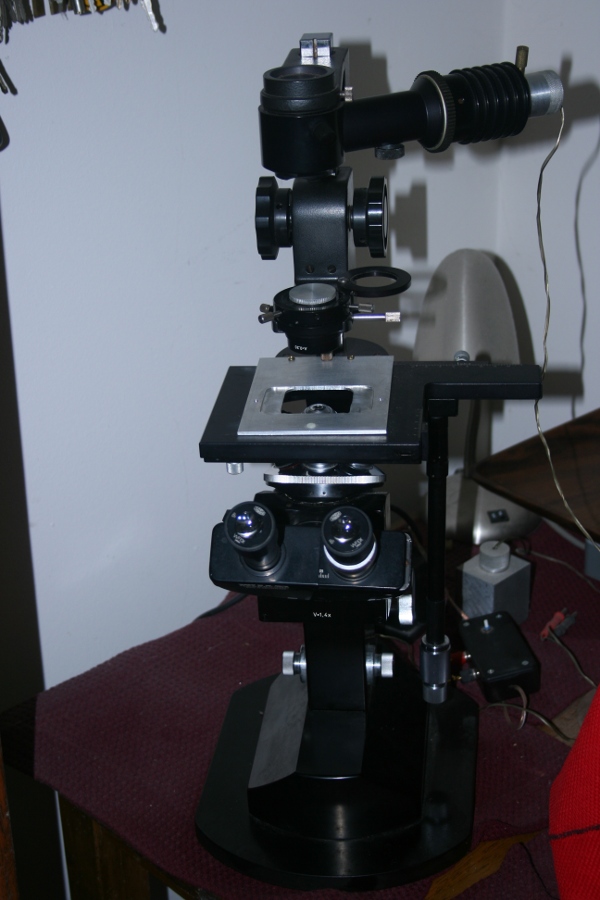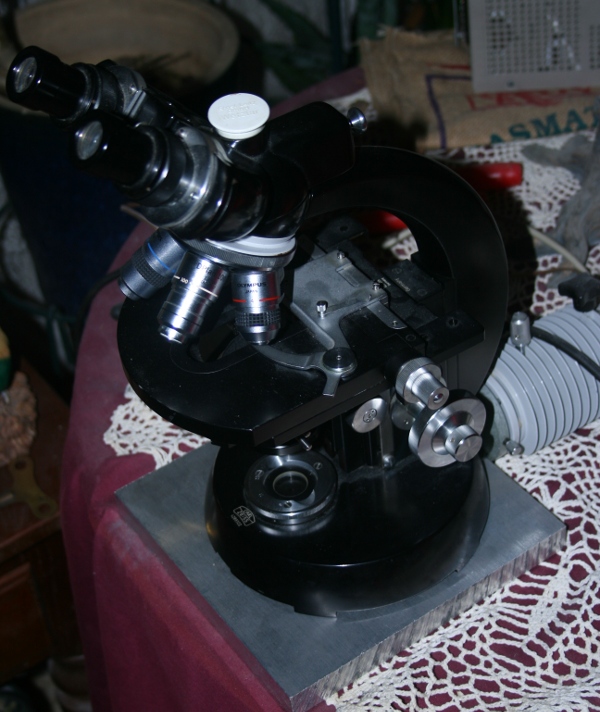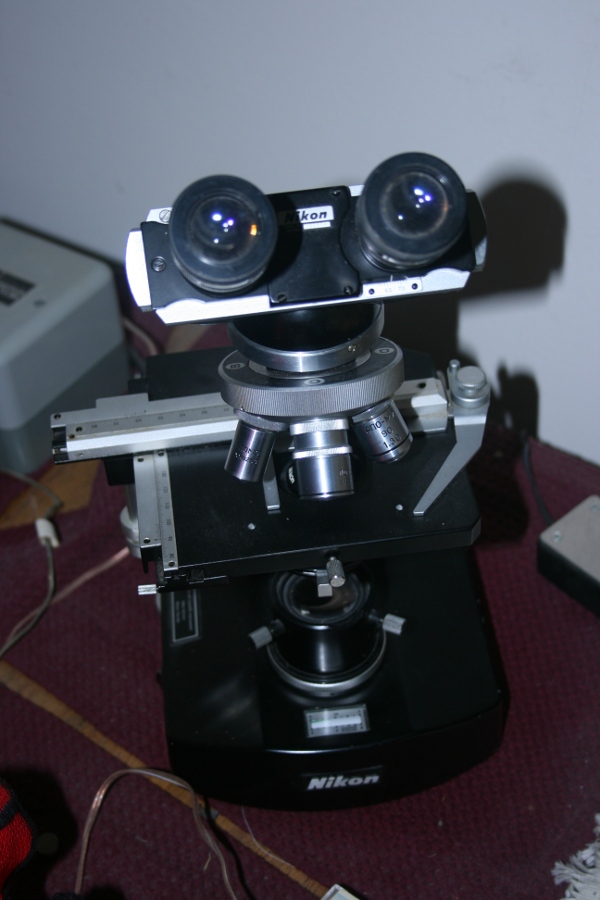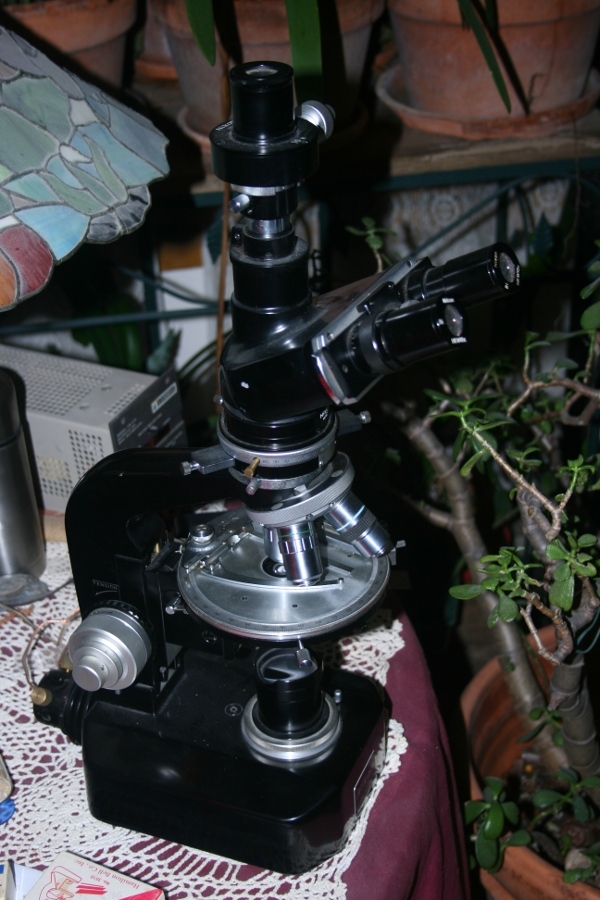It is wise simply to avoid acquiring the instruments with damaged and missing parts that cannot be repaired, replaced, or fabricated!
Most microscopes made prior to the late 20th century used objectives that required an optical tube length of 160 mm. The image distance used by Zeiss and others was 147 mm. Leitz, however, used an optical tube length of 170 mm, and an image distance of 152 mm until they changed to 160 mm in the mid 1970s.
Until recently microscope manufacturers generally rigidly adhered to the RMS thread standards for objectives. This standard is a 0.8 inch Whitworth thread of 36 threads/inch. The "infinity" objectives produced by Wild-Leitz (Leica) and Nikon deviate from this standard. (Of course metallurgical objectives by their very nature are NOT compatible to this standard.)
This means that 160mm and 170mm tube length objectives can be interchanged between instruments, regardless of the manufacturer. HOWEVER, objectives vary in the distance between the face of the nose piece and the plane of focus! The RMS standard is 31mm, the JIS (Japanese) standard is 36mm, and the DIN (German) standard is 45mm. It is EXTREMELY undesirable to have a microscope that has objectives that are not all of the same standard. (DIN is preferable, because the longer objectives leave more room for better optical design for higher power ones. Most more modern finite objectives are DIN.)
There is also another factor: Finite optics oil immersion and high power dry objectives almost always require "compensating" oculars to correct for chromatic difference of magnification. Lower power objectives are generally made to do this to avoid having to change oculars when changing powers. Images will be colour fringed when there is mismatch between oculars and objectives!!! This is NOT good!
Finally there is the issue of phase objectives. Phase objectives have a special phase plate that throws light passing directly through the instrument out of phase with light that is deviated. An image of a special annulus in the condenser must be projected exactly onto the phase plate. Different manufacturers tend to make condensers and objectives that do not match! Upright microscopes almost always have the phase annuli built into condensers. This seems a manoeuvre by manufacturers to force brand compliance!!! (Note, however, that many inverted microscopes use external phase rings that are not part of the condenser assembly. It is often very easy to machine phase rings for these making it easy to mix objectives from different manufacturers on these instruments.)
Oculars generally are standardised too. The standard ocular for compound microscopes has a 23mm diameter. A few microscopes such as the Leitz Orthoplan use 30mm diameter ones. Most stereo microscopes also use 30 mm diameter ones.
Leitz instruments generally should have Leitz oculars, because of the design considerations that they used with the 170mm tube lengths.
However, it is extremely important that one use the special "compensating" oculars with objectives that require them. (This includes a majority of finite tube length objectives manufactured in the last 50 or so years.) Many compensating oculars are marked with the letter C or K. However, some are not. Simply looking through the ocular at a white sheet of paper will reveal the difference—the field stop will appear red fringed with compensating oculars!
Thus one can interchange 160mm tube length objectives and standard oculars, but there are serious limitations that must be taken into account!
Recently many objectives of Chinese origin have become available, usually they are sold for quite low prices. Many of these are DIN objectives of very high quality. They very often do not carry a manufacturer's mark. The quality tends to vary from extremely high to poor.
There are also quite a few Chinese origin oculars. Most of these seem to be quite good. One must be careful, however when purchasing these for 160mm tube length microscopes, because they tend not to be compensating, and will thus result in images with colour fringes.
Interchanging condensers from different manufacturers can be very difficult to accomplish. Many condensers are mounted by gripping them inside a special compression ring. Unfortunately the diameters used by different manufacturers tend to vary. Furthermore some may not be the correct length.
Some condensers are mounted on dovetail systems (Like, for example the one utilised by some Leitz microscopes such as the Orthoplan.)
Fortunately used research grade microscopes that appear on the market usually have condensers. When they lack them it can be difficult to locate or adapt ones from other instruments. Sometimes one can take apart a condenser from one manufacturer and turn down the housing to fit another manufacturers diameter, but this is fairly rare.
Research grade instruments made in the 1950s and 1960s tend to use special flat filament lamps. With each passing year these lamps become harder to locate. As they become rare, their price has tended to escalate!!! These were a very poor design in the first place because these filaments tended to have to be run at temperatures too low to produce anything approximating daylight. When quartz halogen lamps became available manufacturers quickly abandoned this design.
The currently available white light emitting diodes generally have an emitting surface that is about 4 mm square. This is slightly smaller than the area of the flat filament lamps, but still adequate for most optical systems designed for them. These are inexpensive, and holders can often be machined for them without much effort.
Power supplies are electrical devices, and as such they tend to have much shorter life expectancies than other microscope parts. Some manufacturers tended to produce far better power supplies than others. There are special systems available for powering light emitting diodes, and any power supply that provides the correct voltage and current for flat filament lamps can be used with them.
When a flat filament lamp burns out the best thing to do is not waste money and time replacing it. Convert to a white light emitting diode!
Many types of missing and broken microscope components can be fabricated using a small lathe or milling machine. These metal working machines can also often be used to modify mechanical parts so that they will fit on another instrument.
Sometimes the steel parts of old microscopes are covered with thick layers of rust. Think a bit before discarding these parts! A technique commonly used by archaeologists can quickly remove the rust in a short time. Prepare a 5% solution of sodium hydroxide in water. (Caution, very corrosive, wear safety glasses, and take care! Avoid all contact with skin!) Mix in a glass or plastic vessel. Attach a wire to the corroded steel or iron object. Connect the wire to the NEGATIVE terminal of an automotive battery charger. Try 6 V first. Attach a second wire to a piece of graphite, and attach the other end of this to the positive terminal. Immerse the graphite and the corroded piece in the plastic vessel so that they are submerged in the sodium hydroxide solution and do not contact one another. Turn on the battery charger. Depending on the amount of corrosion and rust the rust will soon fall off the object, leaving bare metal. Remove it from the bath, wash with plenty of water, dry and apply a film of oil to prevent development of more rust.
DO NOT try this with aluminium!!!! The aluminium will simply dissolve. Furthermore, reversing the polarity of the electrodes the iron or steel part will also destroy the part rather than clean it of rust!!!
Binocular and trinocular microscope heads are generally not interchangeable between brands. They tend to differ not only in optical design, but also in mechanical size. Occasionally, however, heads can be interchanged with excellent results.
Mechanical stage systems can quite often be interchanged or adapted from parts from other manufacturers.
Phase telescopes generally are interchangeable, though they can also be fabricated. Paul James described a very good way to do this in the June 2005 issue of Micscape.
Microscopes often require special adjusting tools that are often just tiny square nut drivers. One can often obtain clock and watch keys from clock and watch repair companies for replacements for these.
In the July 2006 issue of Micscape I described upgrading a Wild M40 using non-Wild objectives. I also had to machine a substantial number of components such as a stage top, all the phase rings, LED lamp holder, and the focusing stop.
Since I wrote that article I have been able locate a much better set of objectives:
- Olympus LWDCDplan 40x 0.55 na 0-2 mm adjustable phase
- Olympus LWDCDplan 20x 0.40 na 0-2 mm adjustable phase
- Olympus SPlan bright contrast 20x 0.46 na
- Olympus SPlan dark contrast 10x 0.30 na
- Olympus SPlan bright contrast 10x 0.30 na
- Nikon 4X dark contrast phase
I have also replaced the oculars with an excellent set of Olympus ones. This is now a truly fantastic instrument, with the extraordinary mechanical quality of the Wild M40 frame and the extreme quality of the Olympus optics. The Nikon 4x is an extraordinary objective too. One would have an extremely difficult time locating for any price a new inverted microscope that matches this one!

Zeiss "Junior" with Olympus Dplan optics
A group of my colleagues at my University asked me to try to locate a Zeiss metallurgical microscope for them. I searched various sources for them and came upon an eBay auction item--a Zeiss "Junior" with no optics, and with a light source that had been obtained from another Zeiss instrument. I had a set of Olympus Dplan objectives, and, it seemed to me a good idea to bid on it! I won the bid, and the instrument arrived a few days later. The former owner had made a wooden block on which to sit the microscope because the light source he had installed was too large to enable allowing the microscope to sit directly on a table. I took an aluminium block and cut it to the correct size and use that instead. The iris diaphragm in the base was damaged--I fixed this, and then installed my set of Olympus Objectives. What I had was an instant wonderful instrument! I eventually replaced the flat filament lamp in the lamp house with a K2 star LED.
The Olympus objectives and Zeiss microscope work perfectly together. The final result is a fantastic instrument with minimal investment.

Nikon S Series Microscope with LOMO apochromats
Some time ago I obtained three Nikon S series microscopes, all three of which had serious problems. I disassembled all three of them and combined the best parts to make one really good microscope. When the Soviet Union collapsed it was possible to obtain LOMO apochromats for amazingly low prices. I had a set of these, and I put them on this Nikon S instrument. The net result was another amazingly good instrument with little investment.

Nikon S Series Polarising Microscope with (mostly) Chinese Objectives
At the same time I was searching for the metallurgical instrument for colleagues I came upon a modified Nikon S series polarising microscope, again on an eBay auction, that was selling for dramatically less than the normal selling price of such instruments. It was set up for dispersion staining, and had only a dispersion staining objective. It lacked a few parts too, but they were standard Nikon S series parts, and I used the ones from the many spare parts I had as a result of the construction of the instrument described above. I did have to machine the knob that moves that upper polariser in and out of the optical beam.
I eventually located five Chinese polarising objectives of recent manufacture. From these five I found three that are really excellent, a 10X, a 25X and a 40X. I had two Zeiss 4X objectives, and found that one of them really had virtually no birefringence, so I incorporated it as the low power objective.
Recently the power supply failed. I used this as an excuse to get rid of the flat filament lamp and replace it with a light emitting diode system!
The instrument is extraordinary at this point.

It is sad that the advent of infinity objectives generally prevents mixing components from different manufacturers because manufacturers have chosen to make their optics only compatible with their microscopes. It has always been the case that some manufacturers make extraordinary microscopes, and others make extraordinary optics. With manufacturers forcing brand compliance in this manner one cannot assemble instruments with the best components.
All comments to the authors via Robert Pavlis are welcomed.
Microscopy UK Front Page
Micscape Magazine
Article Library
© Microscopy UK or their contributors.
Published in the April 2010 edition of Micscape Magazine.
Please report any Web problems or offer general comments to the Micscape Editor.
Micscape is the on-line monthly magazine of the Microscopy UK website at Microscopy-UK
© Onview.net Ltd, Microscopy-UK, and all contributors 1995 onwards. All rights reserved. Main site is at www.microscopy-uk.org.uk with full mirror at www.microscopy-uk.net .